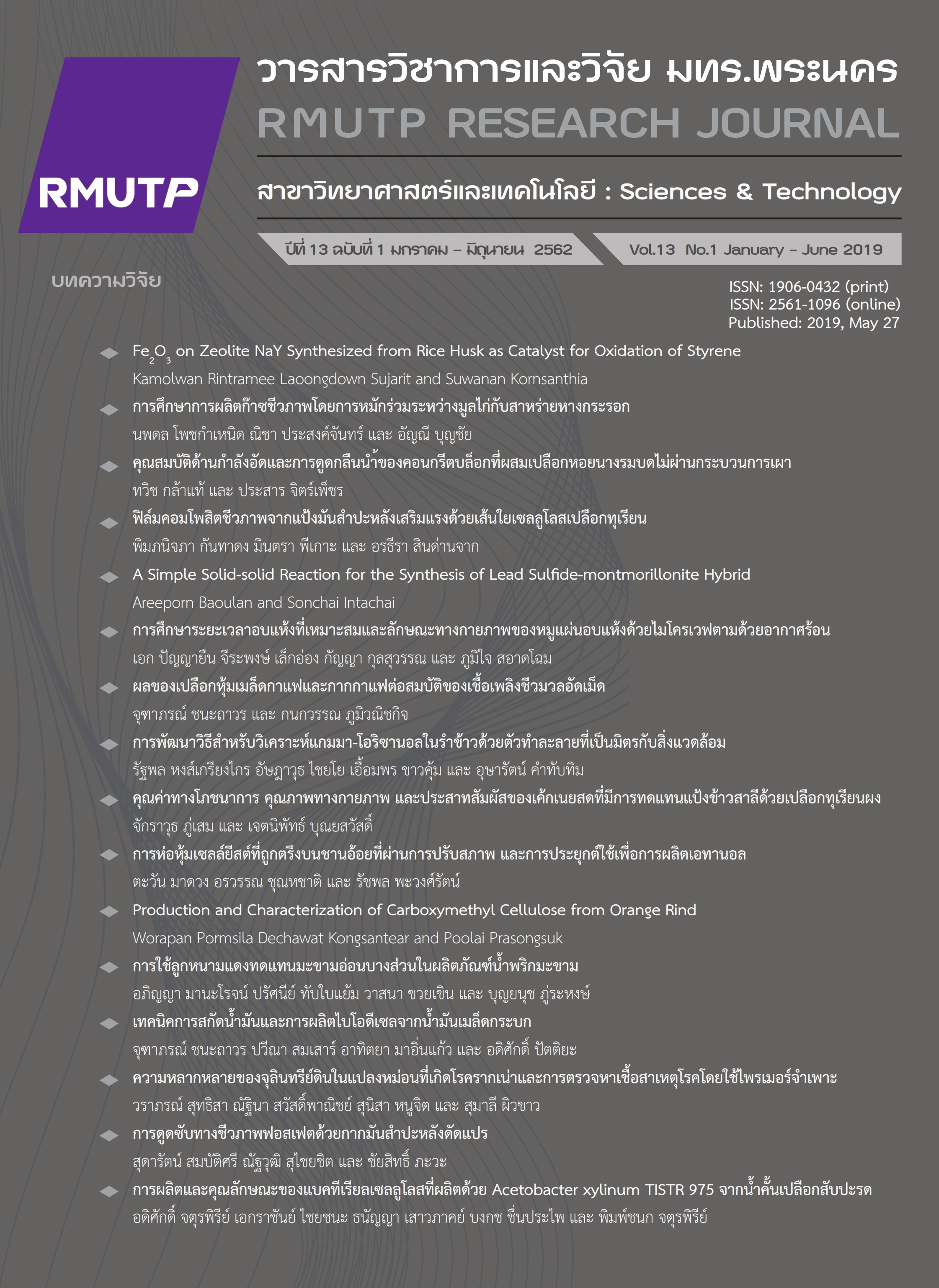คุณสมบัติด้านกำลังอัดและการดูดกลืนน้ำของคอนกรีตบล็อกที่ผสมเปลือกหอยนางรมบดไม่ผ่านกระบวนการเผา Compressive Strength and Water Absorption Properties of Concrete Block Containing Crushed Oyster Shell
Main Article Content
Abstract
The research aims to investigate the possibilities of crushed oyster shell (OS) not have to go through the process of burning as a substitution cement for concrete blocks. The cement was replaced with crushed oyster shell not process burning (OS) at 0%, 10, 20, 30, 40 and 50% by the weight of the binder. After that the concrete blocks were tested to determine the compressive strength and moisture absorbed of the concrete blocks cured for 7, 14, 28, 56 and 90 days. The result showed that the compressive strength of the concrete blocks which replaced cement with OS (at the proportion of 10% by the weight of the binder) at 28 days had the compressive strength and water absorbed accordance with the TIS 58-2533 on non-load bearing concrete blocks. Moreover, the concrete blocks which replaced cement with OS at the proportion of 20% and 30% had the compressive strength equivalent to 28 days compressive strength of TIS 58-2533 standard at 56 and 90 days, respectively and decreased when the percentage in addition to OS in concrete blocks of 40 and 50%. Tested results also showed that the water absorbed of concrete blocks increased when the percentage of replacement of OS in binder increased at 10, 20, 30, 40 and 50%. The economical of concrete blocks it has manufactured unit cost is 2.60 baht. Whereas the concrete block containing crushed oyster shell at 10-30 % it has manufactured unit cost at 2.12-2.44 baht, respectively.
Article Details
References
[2] S. Srisang, U. Suwakantagul and S. Ngaosiprai, “Study of the optimum ratio of composite materials. For non-weighted concrete blocks containing Portland cement, sand and coconut fiber,” Journal of Industrial Education, vol1, no.1, pp. 77-87, 2007.
[3] W. Bamrungthai, “The Experiment on using Mae Moh EGP’s Fly Ash to replace some percents of Portland Cement in Concrete Block Manufacturing for general building construction,” Bachelor Degree of Industrial Technology in Mining Technology Faculty of Engineering Rajamangala University of Technology Lanna, Chiang Mai, Thailand, 2008.
[4] V. Munsrakest, “Strength development in concrete block manufactured from calcium carbide residue and fly ash,” Thesis for Master of Engineering Program in Construction and Infrastructure Management, School of Civil Engineering Suranaree University of Technology, Nakhon Ratchasima, Thailand, 2011.
[5] S. Garaged, “Compressive Strength of Interlocking Block Manufactured From Cement and Crushed Golden Apple Snail Shell,” Thesis for Master of Engineering Program in Construction and Infrastructure Management, School of Civil Engineering Suranaree University of Technology, Nakhon Ratchasima, , Thailand, 2014.
[6] W. Kroehong, S. Sangpaen, P. Sitkanarak and J. Wilairat, “Mechanical Properties, Microstructure and Thermal Conductivity of Concrete Block Containing Fly Ash,” KMUTT Research and Development Journal, vol. 39, no. 3, pp. 407-424, 2016.
[7] S. Hirunmasuwan and S. Isarangkul Na Ayuthaya, “The Utilization of Rice Hush Ash and Fly Ash as Pozzolanic Materials for Stabilization and Solidification of Chromium Sludge in the Form of Concrete Interlocking Block for Using as Construction Materials,” Journal of Science and Technology, vol. 25, no. 6, pp. 1072-1082, 2017.
[8] Surat Thani Provincial Administrative Board, Surat Thani Provincial Office, “Surat Thani Town Plan (2018-2021),” 277 p. , 2016.
[9] Fishery Statistics Analysis and Research Group, Information and Communication Technology Center, Department of Fisheries, Ministry of Agriculture and Cooperatives 2017, “Statistics of Marine Shellfish Culture Survey 2015,” 34 p., 2017.
[10] ASTM Standard C150, American Society for Testing and Materials, “Standard Specification for Portland Cement,” Annual Book of ASTM Standard, (Vol.4.01), PA, USA., 2015.
[11] ASTM Standard C188, American Society for Testing and Materials, “Standard Test Method for Density of Hydraulic Cement,”. Annual Book of ASTM Standards, 2009.
[12] Thai Industrial Standards Institute (TISI)., “Standard for Sampling and Testing. Concrete Mansory Units TIS.109-2517.,” Ministry of industry, Bangkok, 1974.
[13] Thai Industrial Standards Institute (TISI)., “standard of concrete block on non-load bearing concrete blocks TIS. 58-2533,” Ministry of industry, Bangkok, 1990.
[14] P. Lertwattanaruk, N. Makul, and C. Siripattarapravat, “Utilization of ground waste seashells in cement mortars for masonry and plastering,” J. environ. Manage., vol. 111, pp. 133-141, 2012.
[15] T. Klathae, “Utilization of Crushed Oyster Shell on Interlocking Block,” RMUTP Research Journal, vol 11, No. 2, pp. 167-177, Jul.-Dec. 2017.
[16] ASTM Standard C618, American Society for Testing and Materials, “Standard specification for coal fly ash and raw or calcined natural pozzolan for use in concrete,” Annual Book of ASTM Standard, , (Vol.04.02), PA, USA., 2011.
[17] C. Jaturapitakkul, S. Jeangkaseamchokchai and W. Kunavanakij, “Chemical and Physical Properties of Fly Ash,” Seminar on the use of fly ash in concrete, pp. 7-19, 1999.
[18] C. Boonchar, P. Parnsab and A. Maneechai, “Cockle Shell Grinder,” Thesis for Bachelor of Industrial Education Program in Industrial Education mechanical engineering Faculty of Technical Education, Rajamangala Institute of Technology Krungthep, Bangkok, 107 p., 2015.


